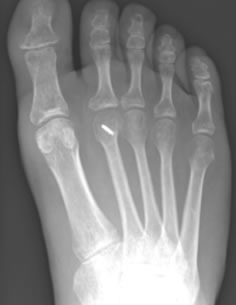in Foot and Ankle Surgery and Reconstruction
Many operations to relieve pain under the metatarsal head or elevate the metatarsal have been described. Quite a common one performed is the Weil Osteotomy. It is usually performed in the 2nd, 3rd or 4th metatarsal but can also be done on the 5th as needed. It is often performed in conjunction with bunion surgery but similarly can be done as an isolated procedure.
It is a day-case procedure. The operation is done under a general anaesthesia and an added injection in the foot to numb it for after surgery. The operation will involve generally 1 incision around the area where your toe meets the foot, on the top of the foot. If more than one metatarsal is to be operated on then more than one incision may be used. The procedure involves carefully cutting the bone (osteotomy) to reposition the bone effectively shortening the bone slightly to relive the pain under the foot and/or toe clawing. The osteotomy is then held in place with a small metal screw that stays in long-term. Dissolvable skin stitches may be used.

Your foot will be bandaged, numb and pain free. You will see a physiotherapist who will advise on walking in a padded stiff shoe supplied. You will be discharged only when comfortable and given an appointment and pain-killers as required.
In the first 2 weeks keep the bandaging totally dry. You may shower with a waterproof cover over the foot. After 2 weeks you can only shower if the wound is healed but gently dab the wound dry.
Once out of bandaging, do not pull at scabs but let them fall away naturally. If your wound becomes red, swollen or sore you need to see your Consultant to ensure there is no infection present. Your physiotherapist may advise on wound massage when it has healed.
Your physiotherapist will guide you through the stages of rehabilitation including gait re-education, toe mobilisation exercises, swelling reduction and reducing muscle tightness. It is important to adhere to advice given.
It is important to perform gentle toe stretches as instructed by the physiotherapist.
DVLA states it is the responsibility of the driver to ensure they are always in control of the vehicle. A good guide is if you can stamp down hard with the foot to stop the car in an emergency stop. This will take at least 6 weeks. Click here to read DVLA guidance.
This is very individual and job-dependent. Below is a guide:
Excellent symptom relief once the toe has healed, which can take 6 weeks. Good level of activity and sports by 3 months. 6-12 to be fully recovered with full sports and activity. Mild swelling and stiffness in the toe can persist in the foot for up to a year.
Any operation carries a risk. Below is a guide to some risks potentially encountered. It is the surgeons duty to fully inform you of possible risks. Mr Roche will ensure this is always done so patients can make safe and informed choices about their operation.
If this happens, it is usually simply treated with antibiotics. Significant consequences from infection are very rare but can be dealt with. Risk is around 1%.
Small nerves that supply sensation to the skin are near the incision site. Damage is rare but if your toe stays numb after surgery, the nerve may be bruised. If so it usually recovers. Risk is around 5%.
The toe can remain a little stiff but usually recovers over the course of rehabilitation. Physiotherapy can assist with this.
Symptomatic clot formation in the leg is unusual after foot surgery (<3%). Whether treatment to prevent clot is needed can be discussed with your surgeon. There is no consensus amongst UK Orthopaedic surgeons as to whether preventative medicine is needed.
This document is only meant to be a guideline to help you understand your treatment and what to expect. Every person is different and your rehabilitation may be quicker and slower. This will be advised and guided by your doctor and physiotherapist.